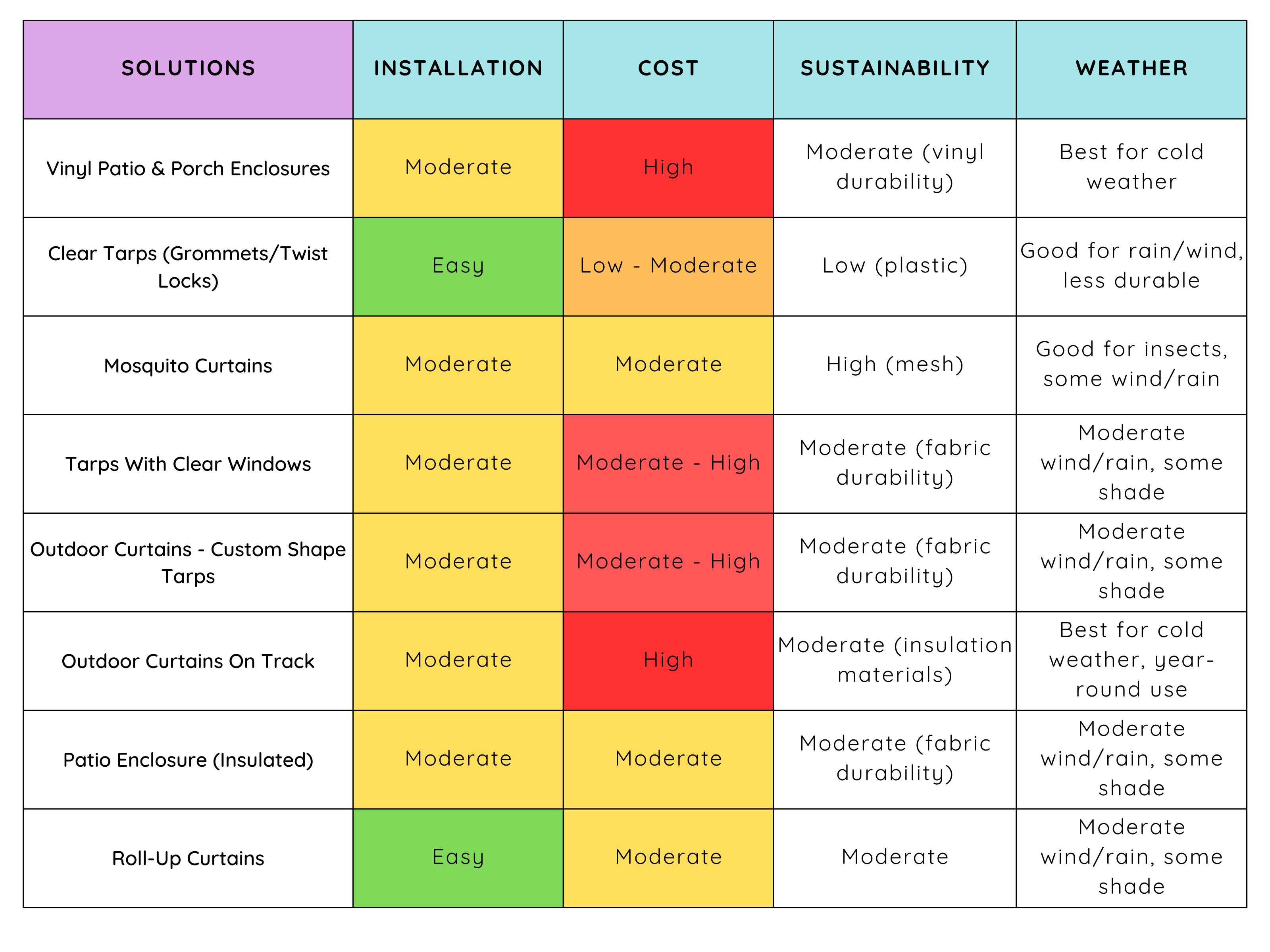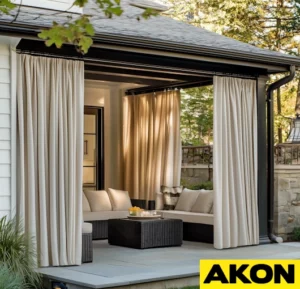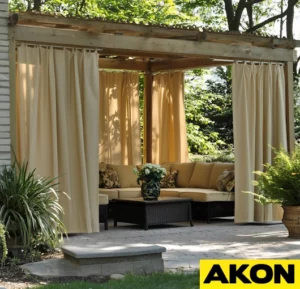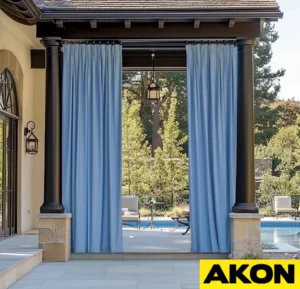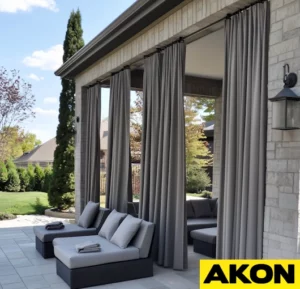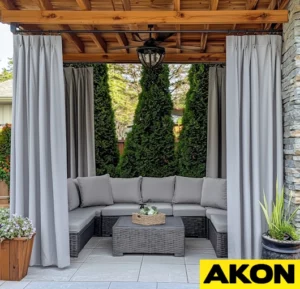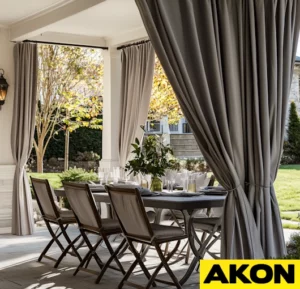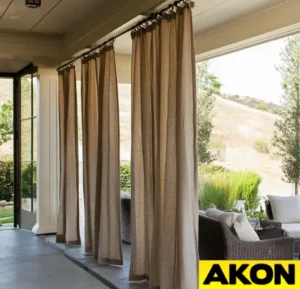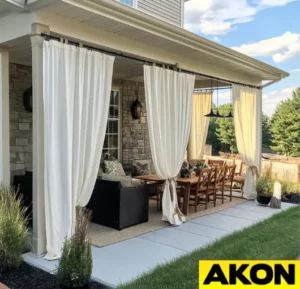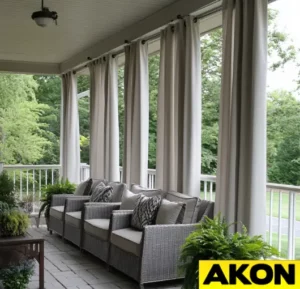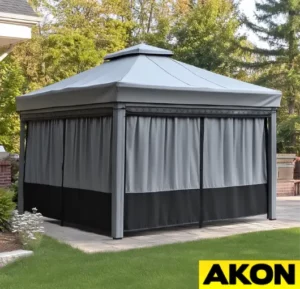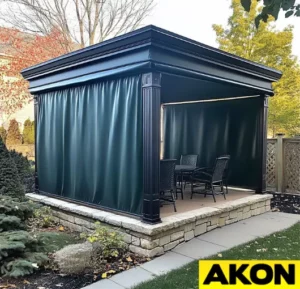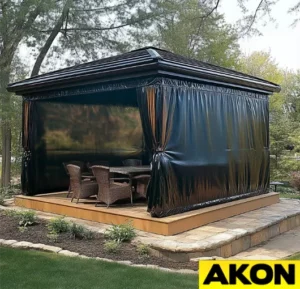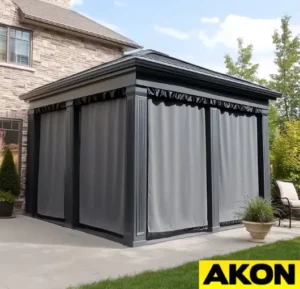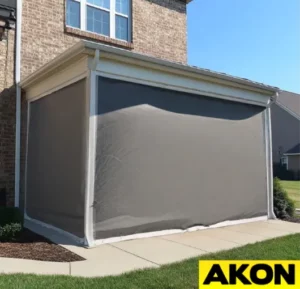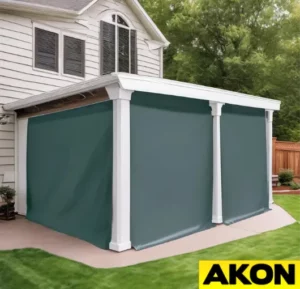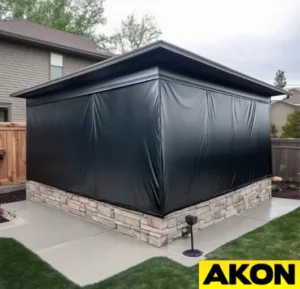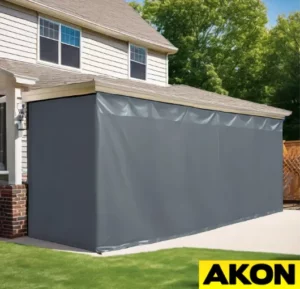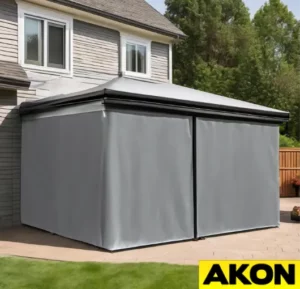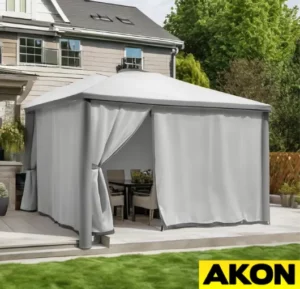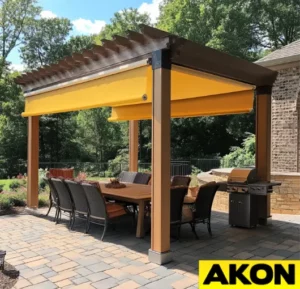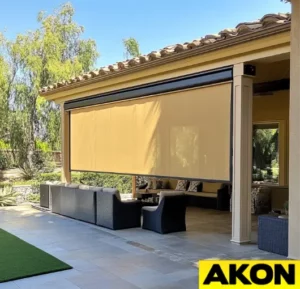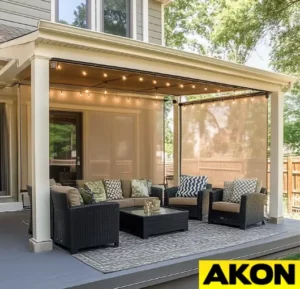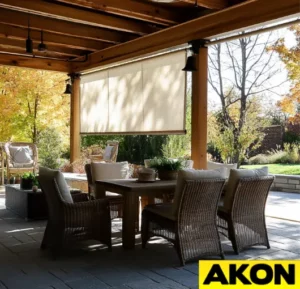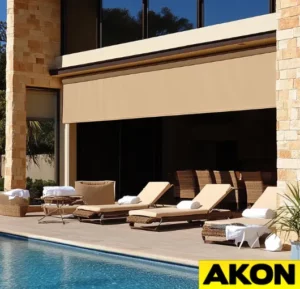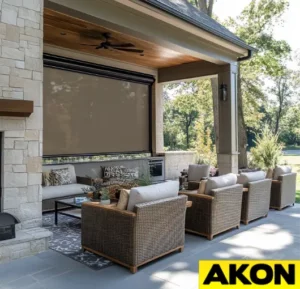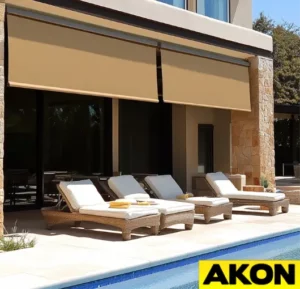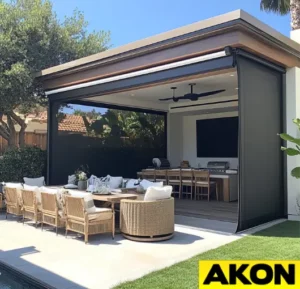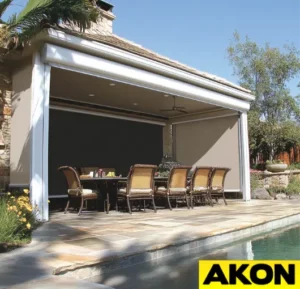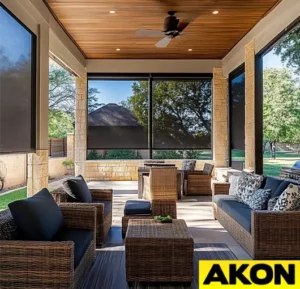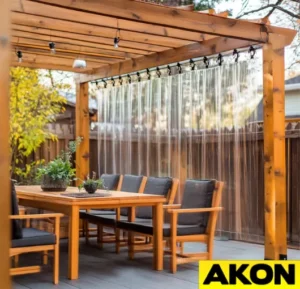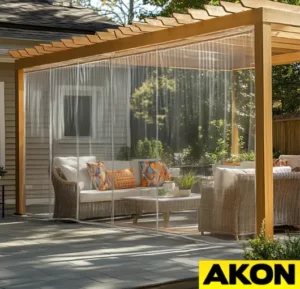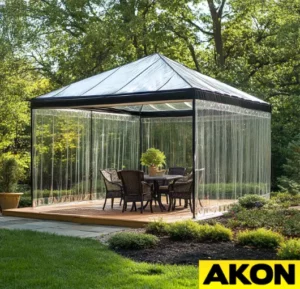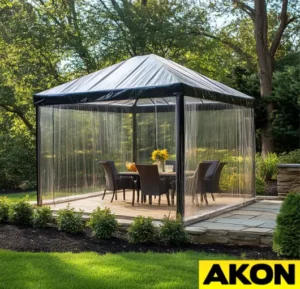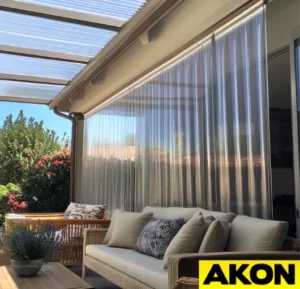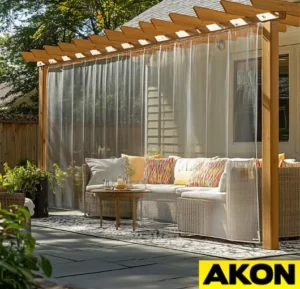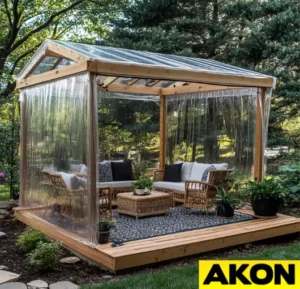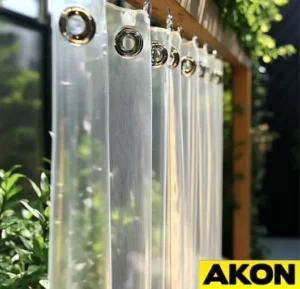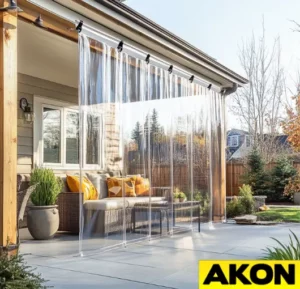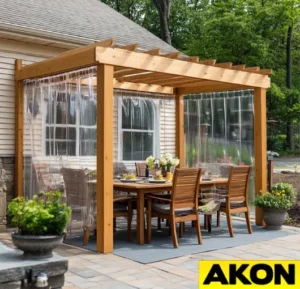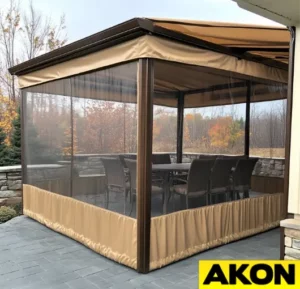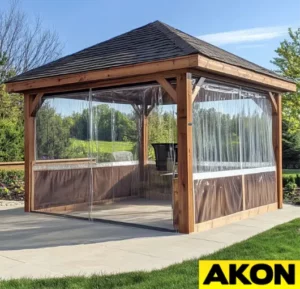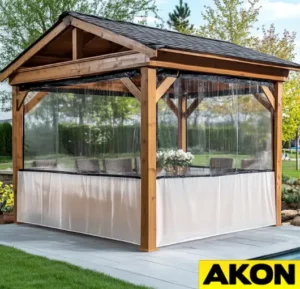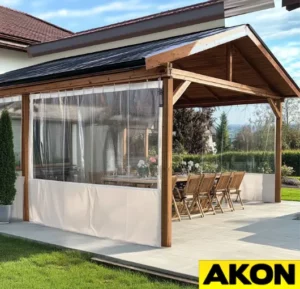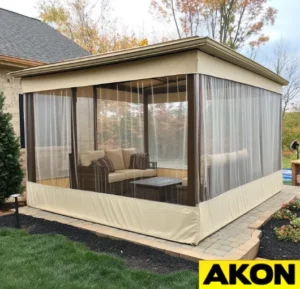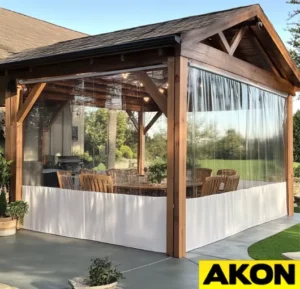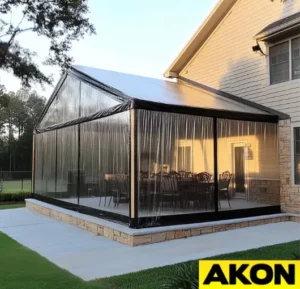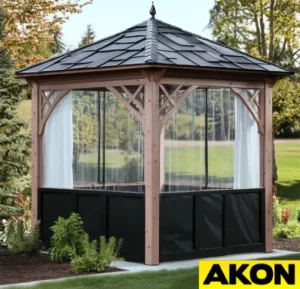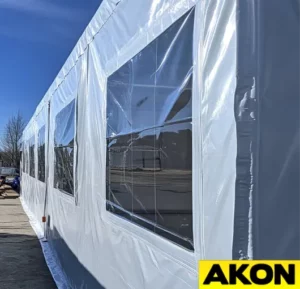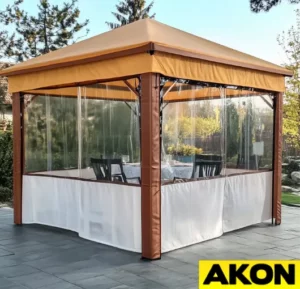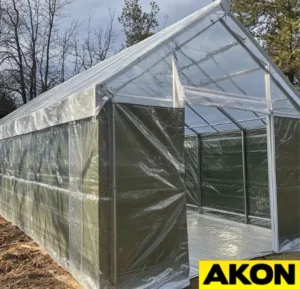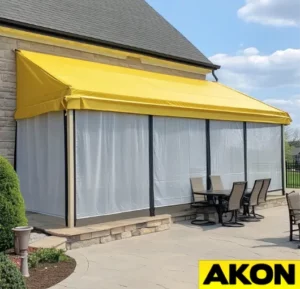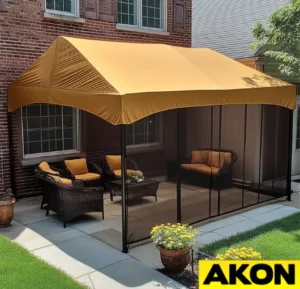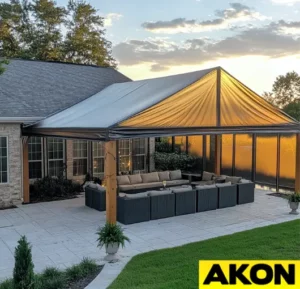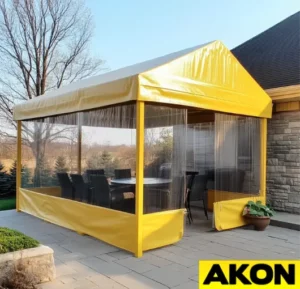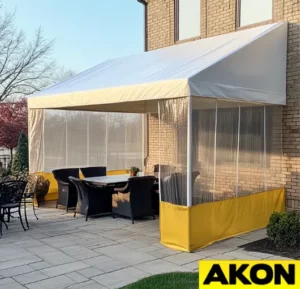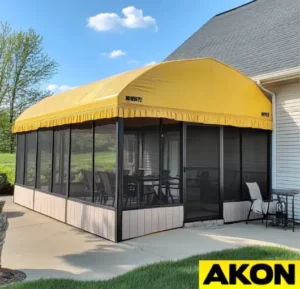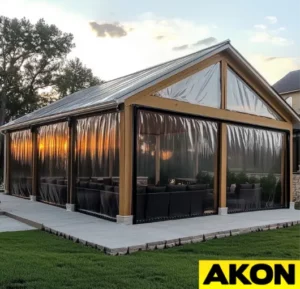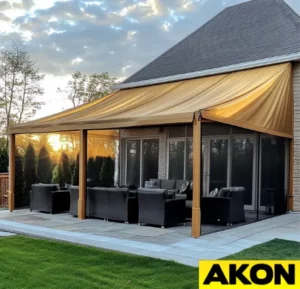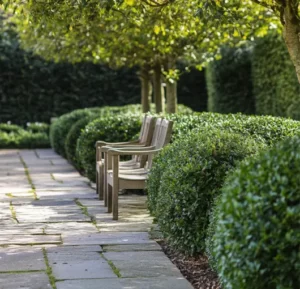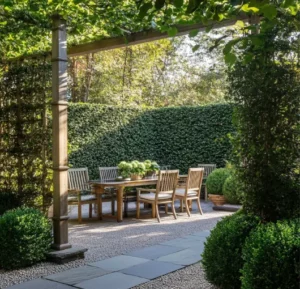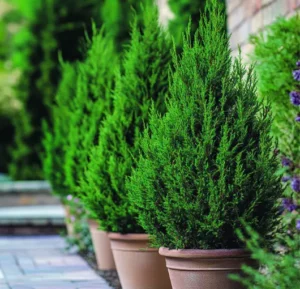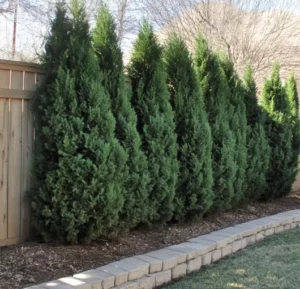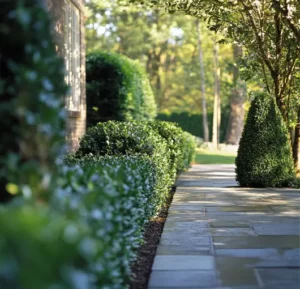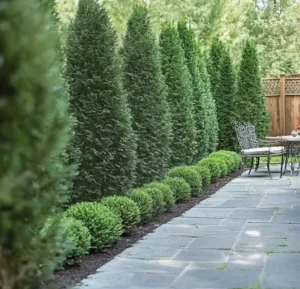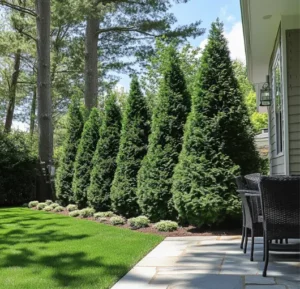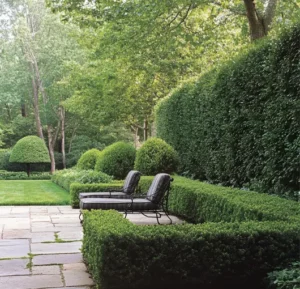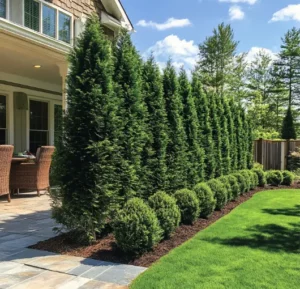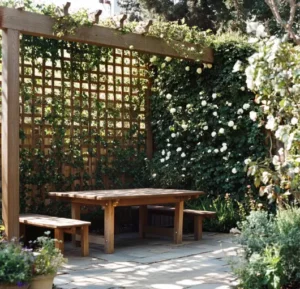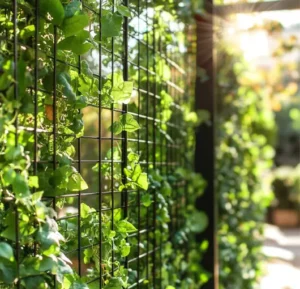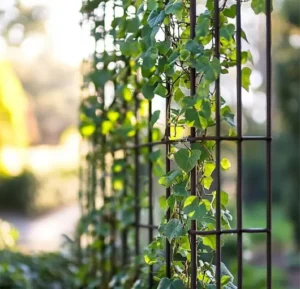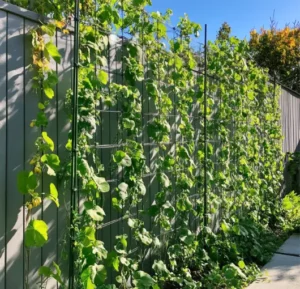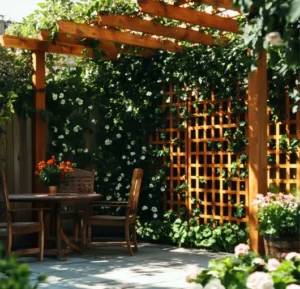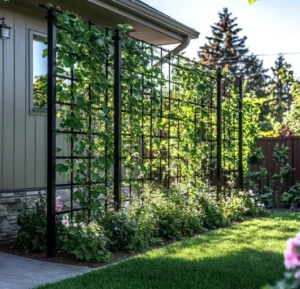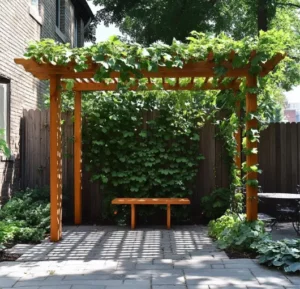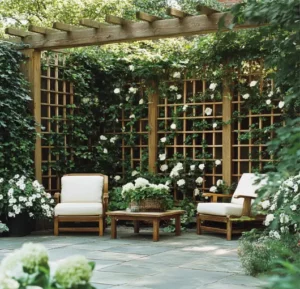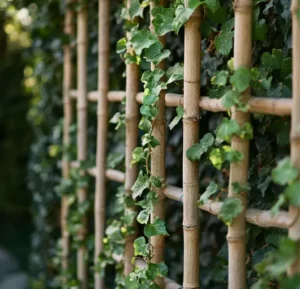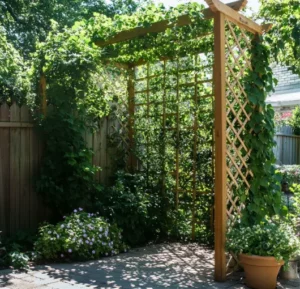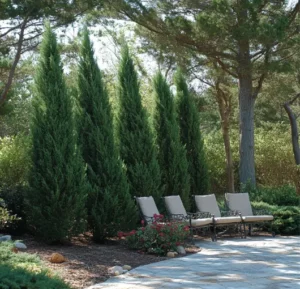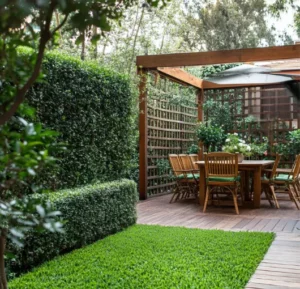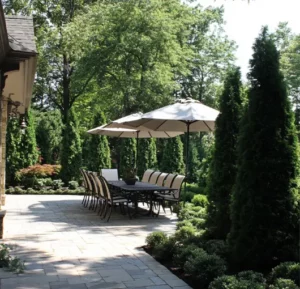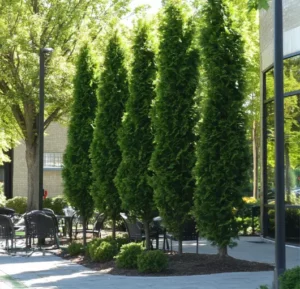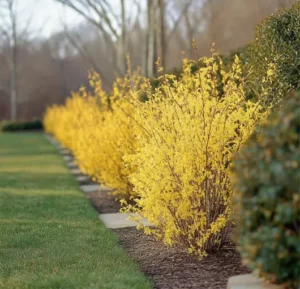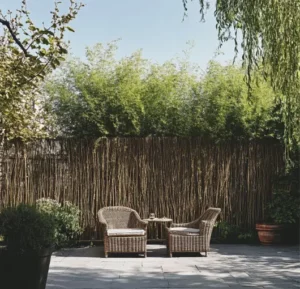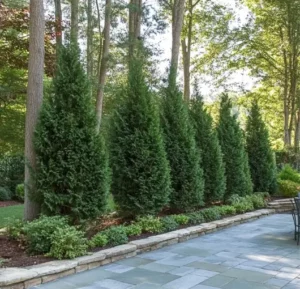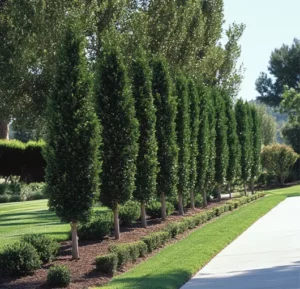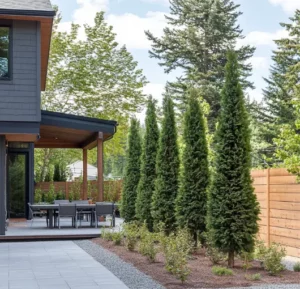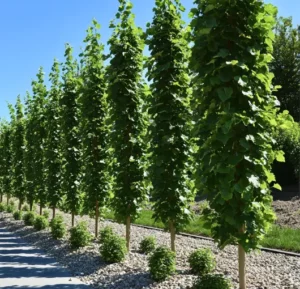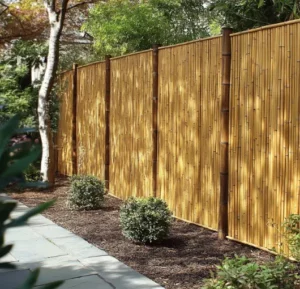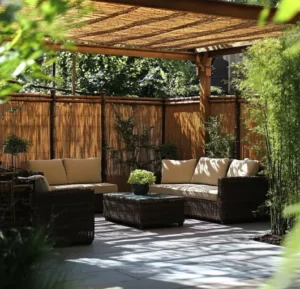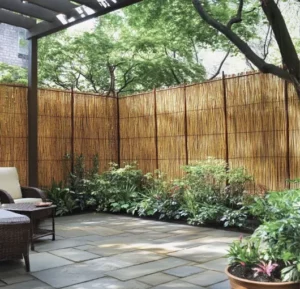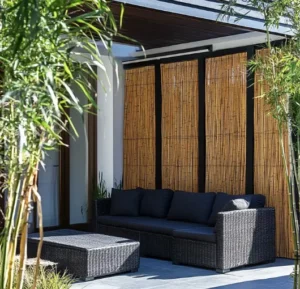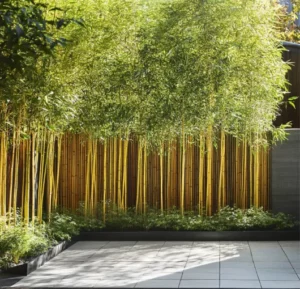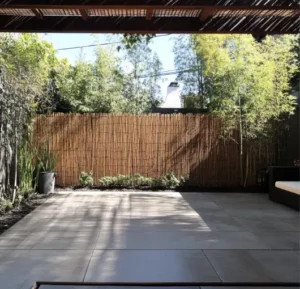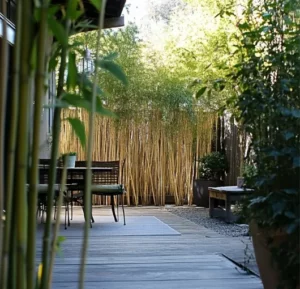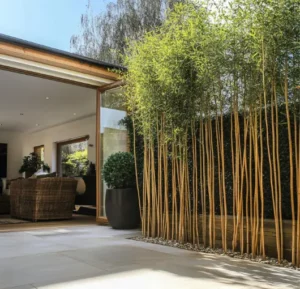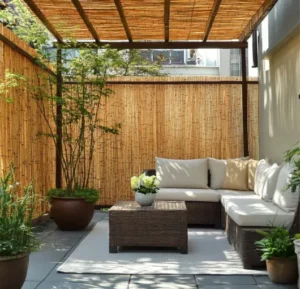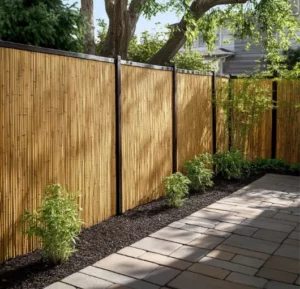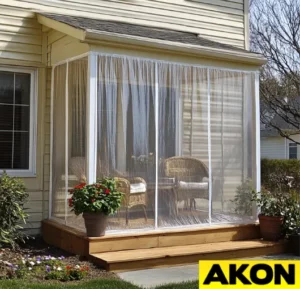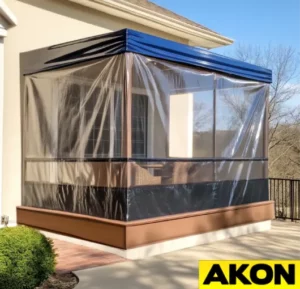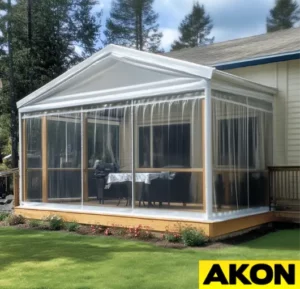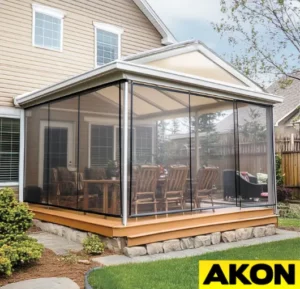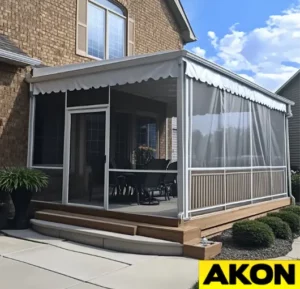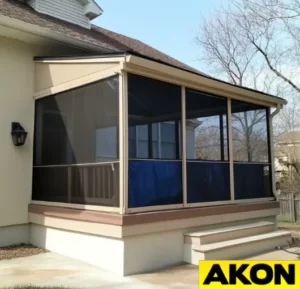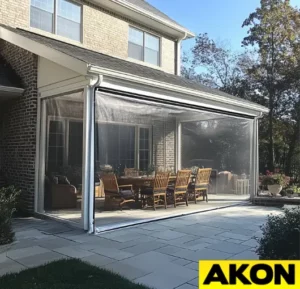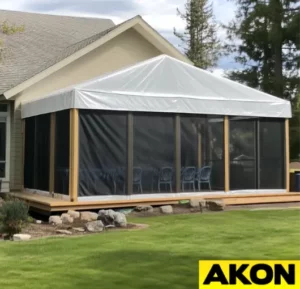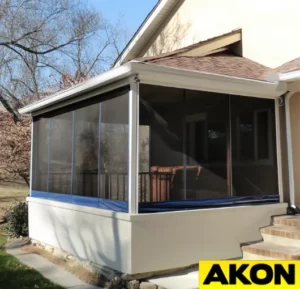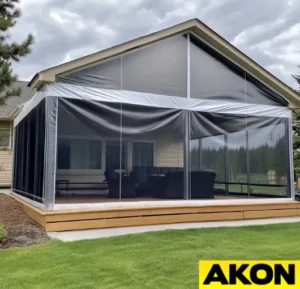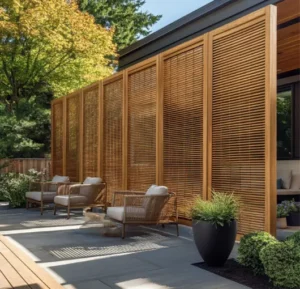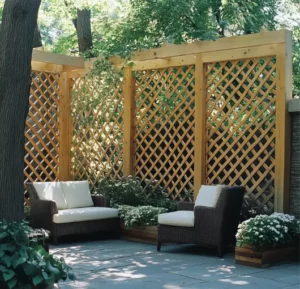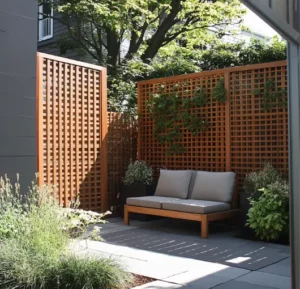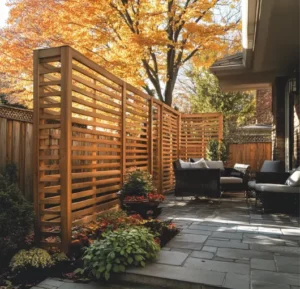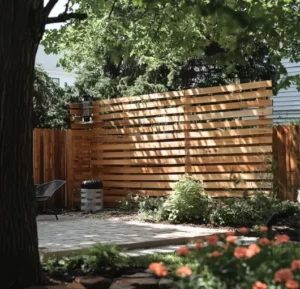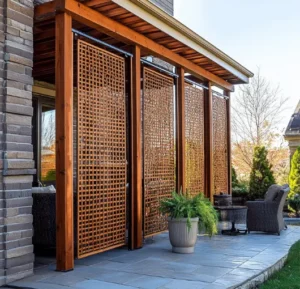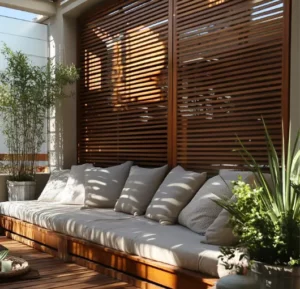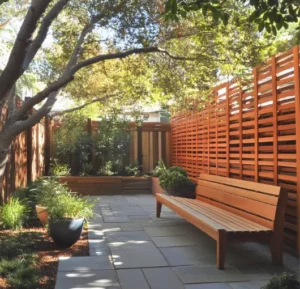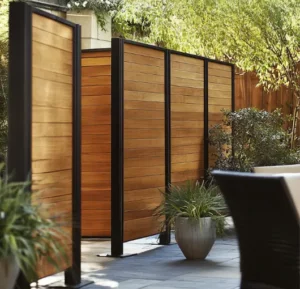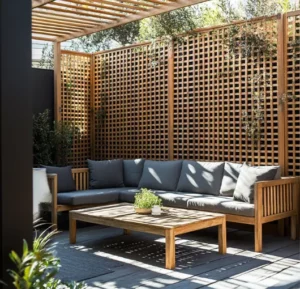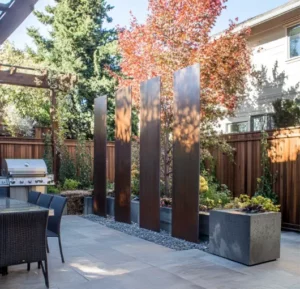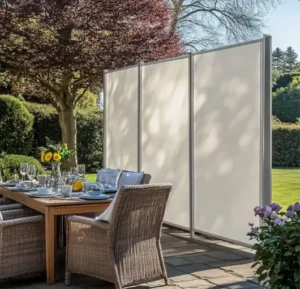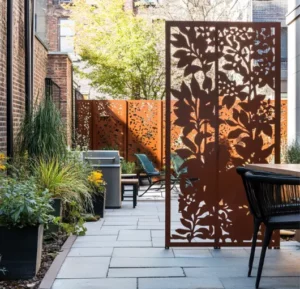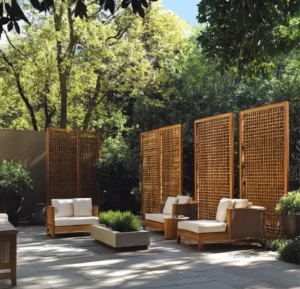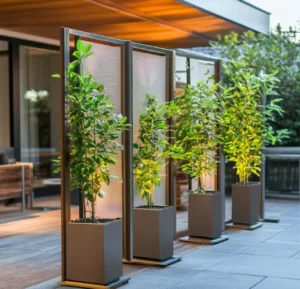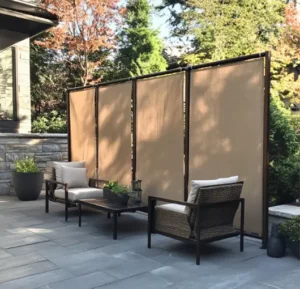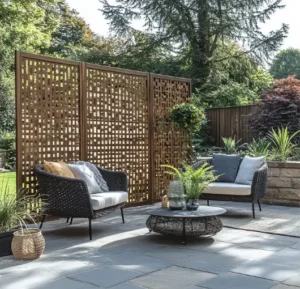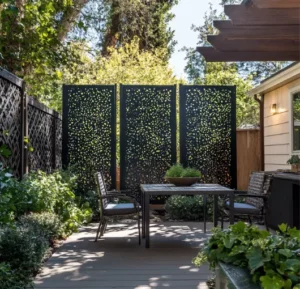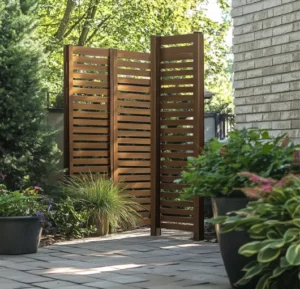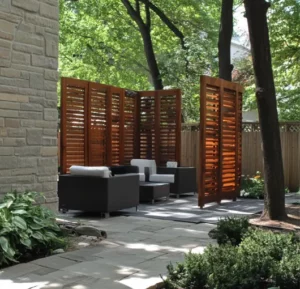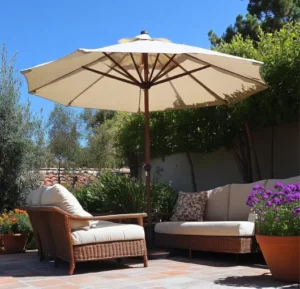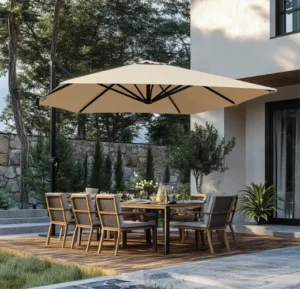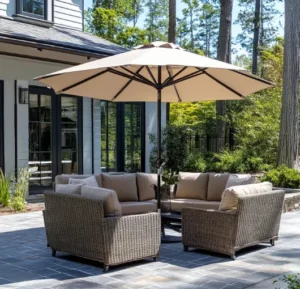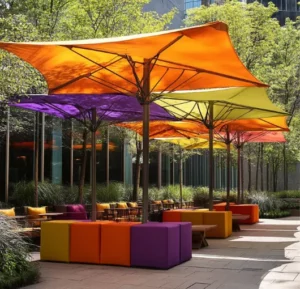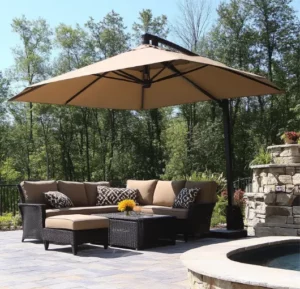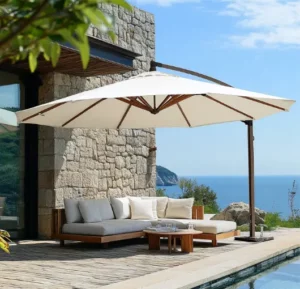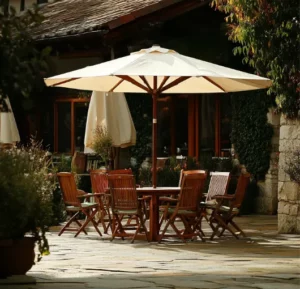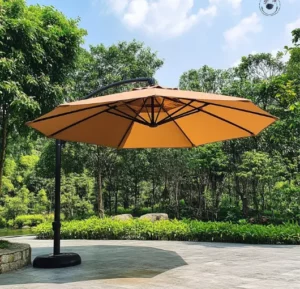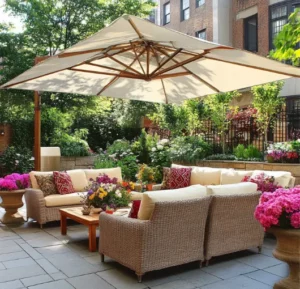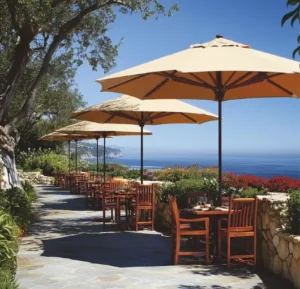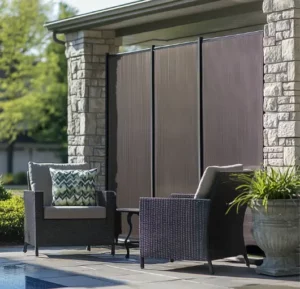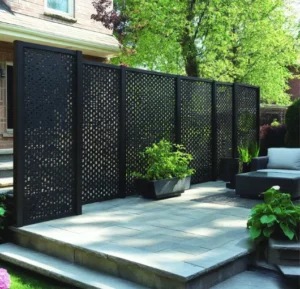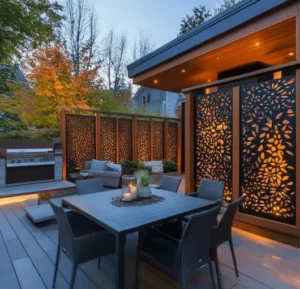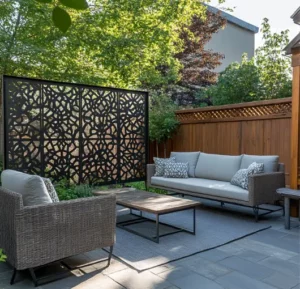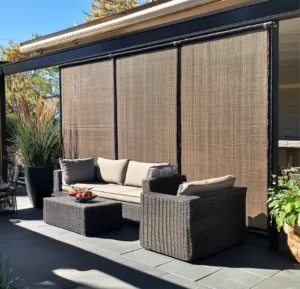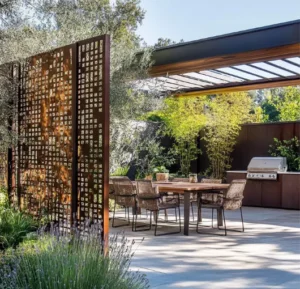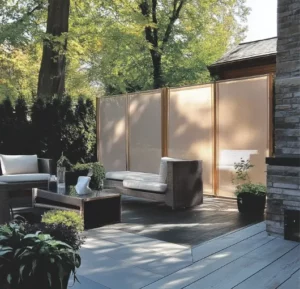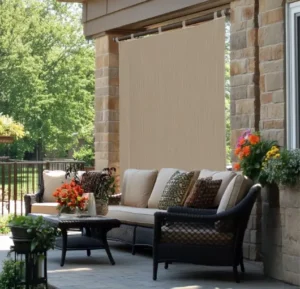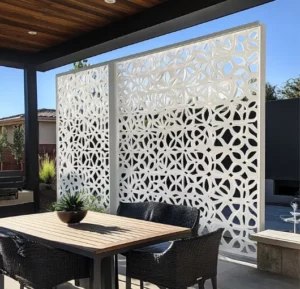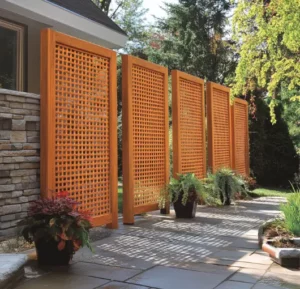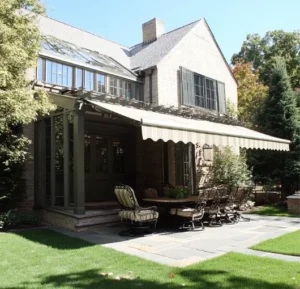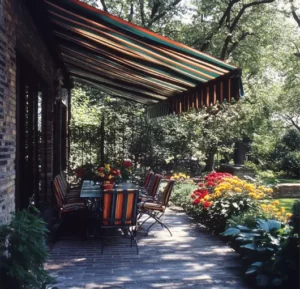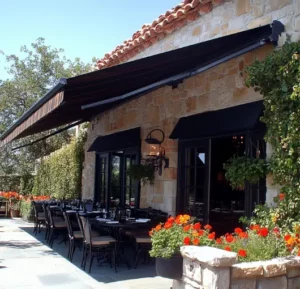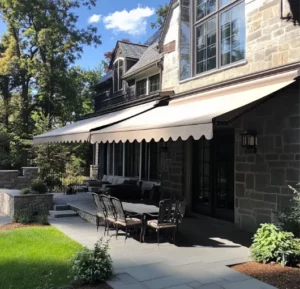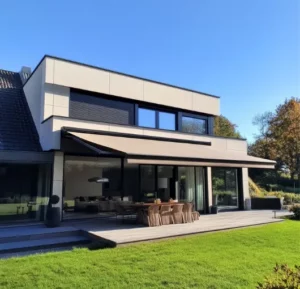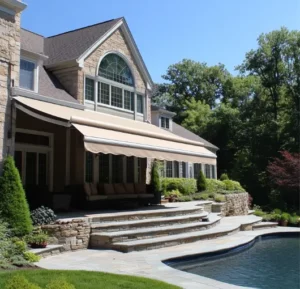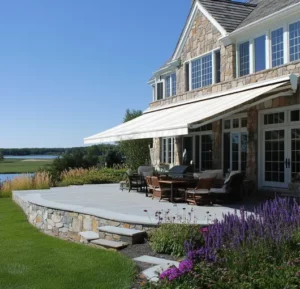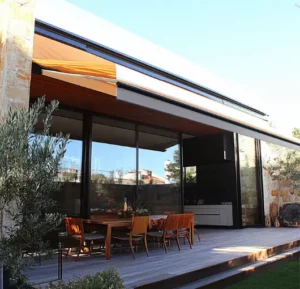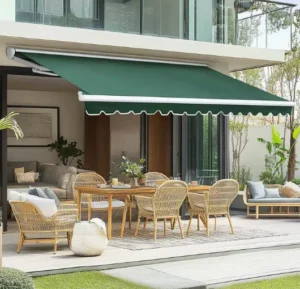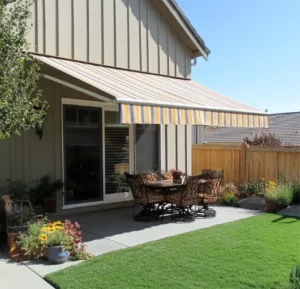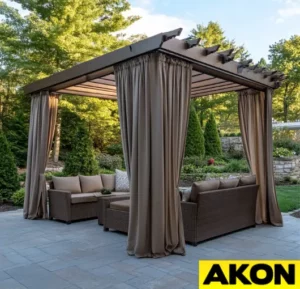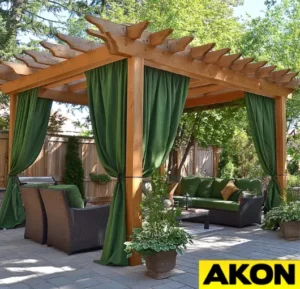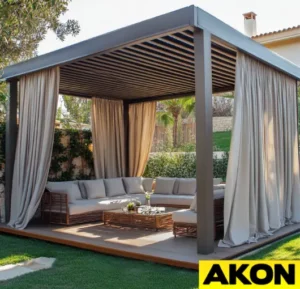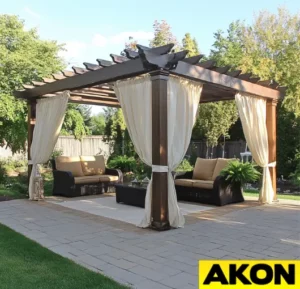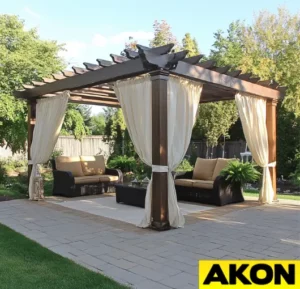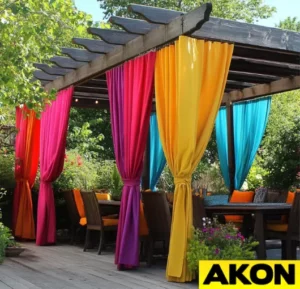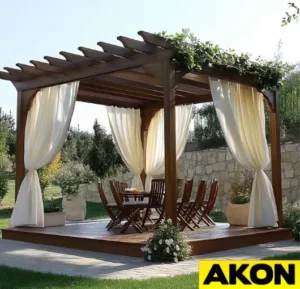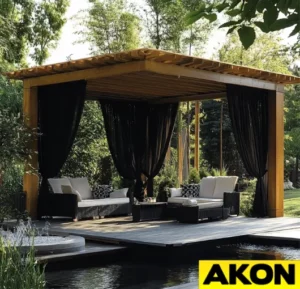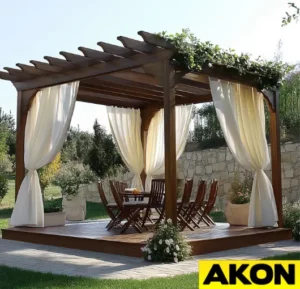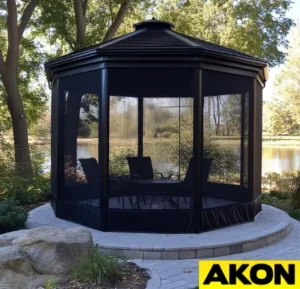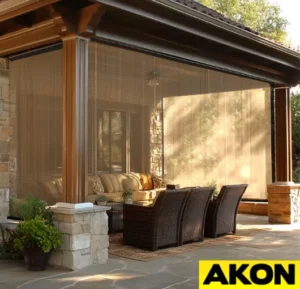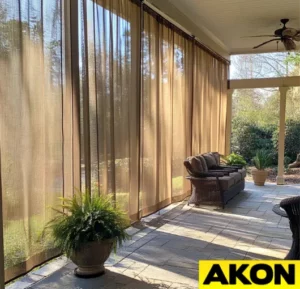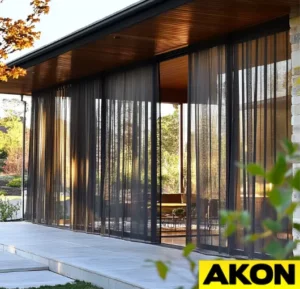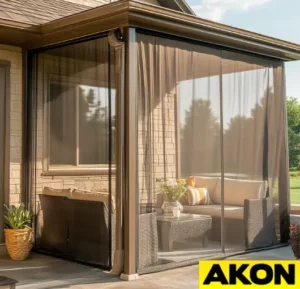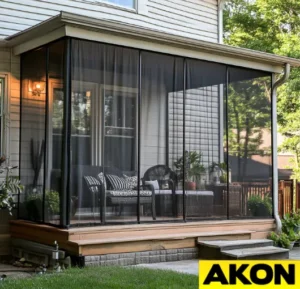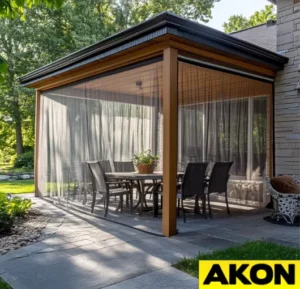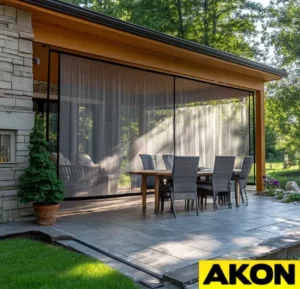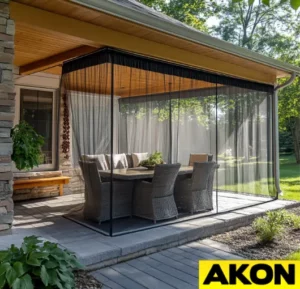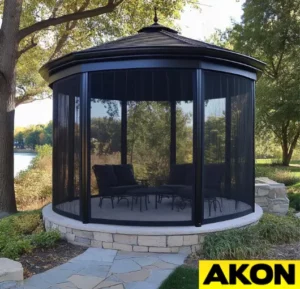What You Will Learn
Frustrated with the wind disrupting your patio time? This post will show you ten fantastic ideas for designing a comfortable outside area. From planting trees to employing chic screens, we will discuss several concepts to help you decide the best approach to block the wind and transform your patio into a peaceful haven.
Table of Contents
CURTAINS - RETRACTABLE
Outdoor Curtains On Track
Insulated Patio Enclosure Curtains
Ourdoor Rollup Curtains
CURTAINS - STATIC
Clear Tarps with Grommets
Tarps With Clear Windows
Custom Shape Tarps
LANDSCAPING
Winbreak Hedges
Trellis With Climbing Vines
Trees
FENCING
Bamboo Screens
Vinyl Patio and Porch Enclosures
Wooden Panels
FREESTANDING
Freestanding Windbreak Panels
Outdoor Umbrellas
Privacy Screens
OTHER PATIO WINDBREAK OPTIONS
Retractable Awnings
Pergola With Curtains
Mosquito Curtains Mesh
Curtains - Retractable
Outdoor Curtains On Track
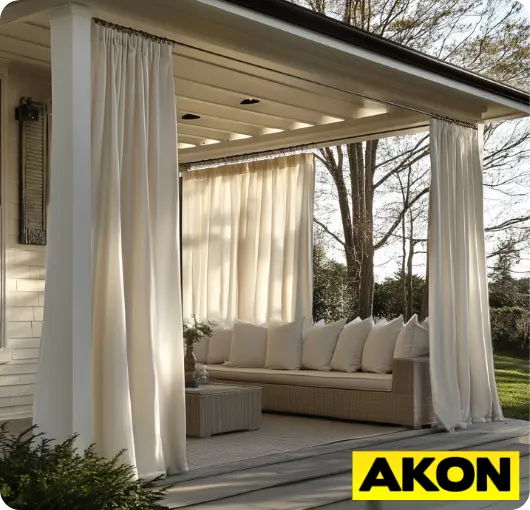
Enjoy your patio all year long from outside drapes on tracks. These flexible drapes cleverly hide wind, rain, even some sunlight, so creating a warm outdoor environment.
They are easy to operate; just open or close the curtains as needed. Installation calls only just basic tools; it is quick and easy.
Outdoor drapes on tracks are a fairly priced fix as compared to building permanent structures or purchasing expensive patio heaters.
Your patio will be more comfortable in cooler seasons if these drapes help to maintain a more steady temperature. Appropriate for different patio sizes and types, they come in a spectrum of colors and designs to accentuate your outdoor décor.
The Pros and Cons
Pros of Outdoor Curtains On Track:
- Flexibility: Depending on the temperature, just open or close the curtains to take in the outside when it's pleasant and cover when it's not.
- Aesthetics: Including some design and privacy will help your patio look better.
- Cost Effective: Generally speaking, more fairly priced than building permanent structures or using other windbreak methods.
- Easy to Install: Usually with little tools and work, you can install quickly yourself.
- Versatility: Provides some shade and privacy apart from wind protection.
Cons of Outdoor Curtains On Track:
- Maintenance: May need for regular dust, dirt, and mildew elimination by cleaning.
- Durability: Perhaps sensitive to damage from even accidental touch, heavy rain, or powerful winds.
- Restricted Wind Protection: May not provide complete defense from strong gusts especially in severely windy areas.
- Subjective: Some would prefer other windbreak options to the look of drapes.
- Over time, the curtains themselves and their tracking can wear out and demand replacement or repair.
Insulated Patio Enclosure Curtains
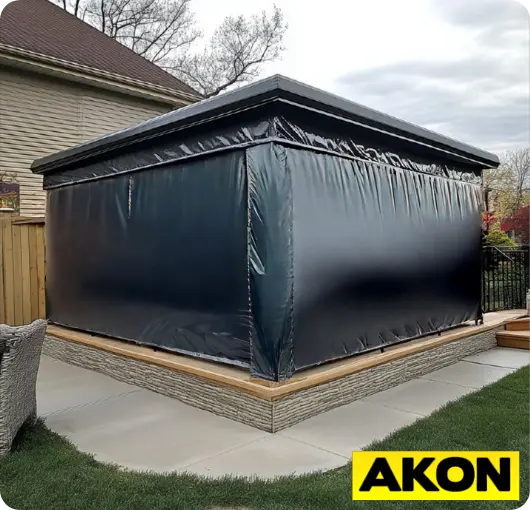
Insulated patio enclosure curtains let you enjoy your outdoor living area right through the coldest months. Made from premium insulating materials, these especially crafted drapes will help to keep your patio comfortable.
Install them only as needed and remove them when you're finished. They are therefore a practical and reasonably priced substitute for creating permanent enclosures.
Apart from keeping the cold out, these curtains assist to lower humidity and regulate noise. From patios to gazebos to screened-in porches, they are flexible and fit for many outdoor projects.
The Pros and Cons
Pros of Insulated Patio Enclosure Curtains:
- Extended Use: Enjoy your patio even in cooler months to lengthen your outdoor living season.
- Energy Saving: Significantly less heat loss helps to possibly minimize heating bills.
- Comfort: Blocks cold and wind, therefore creating a warmer and more pleasant surroundings.
- Versatility: Not only on patios but also on several outdoor constructions.
- Cost-Effective: More reasonably priced than creating a permanent enclosure.
Cons of Insulated Patio Enclosure Curtains:
- Restricted Views: Could block your vision of your surrounds?
- Storage: Some homes find it difficult since, when not in use, it calls for room.
- Installation: Particularly with bigger patios, installation and removal can be time-consuming.
- Aesthetics: Your patio's appearance may suffer if everyone finds your choice to be ugly.
- Durability: Might be easily worn down by constant use and environmental conditions.
Outdoor Roll Up Curtains
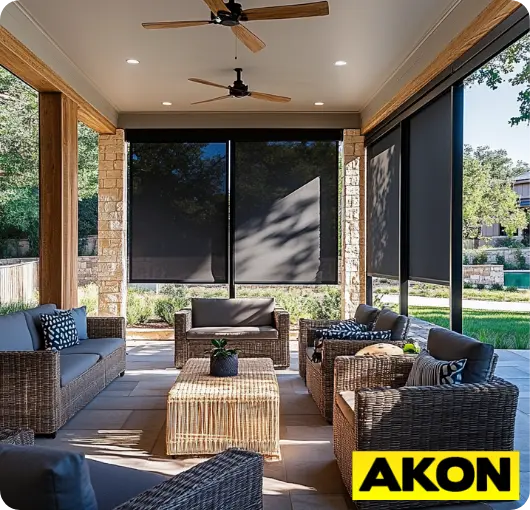
A sensible and reasonably priced way to create a covered and comfortable outdoor sitting area is with Roll Up Curtains. These adaptable curtains are made to roll up and down with simplicity, so offering versatility and convenience.
Made from durable materials resistant to the elements, they efficiently block wind, rain, and snow while also enabling simple access and ventilation. A reasonably affordable way to improve the enjoyment of your patio is roll-up curtains, which cost a fraction of conventional permanent walls.
Roll Up Curtains offer a chic and practical answer whether your main goal is to create a more intimate and cosy outdoor ambiance or you just need cover from the weather.
The Pros and Cons
Pros of Roll Up Curtains:
- Simple to Use: You have great freedom since you can roll them down or up anytime you want. It like having a patio window shade!
- Cost-Effective: Usually less expensive than purchasing other elegant patio covers or installing a permanent wall, they save money.
- Versatile: They can serve to block some of the sun's heat, rain, and even wind.
- Savings of Space: You can neatly roll them up and keep them tucked away when you're not using them to help you save room.
- Easy to Maintain: Usually, all they need to appear excellent is a fast cleaning.
Cons of Roll Up Curtains:
- May Not Block Strong Winds: They might not totally block very strong winds.
- Can Get Damaged Easily: Strong gusts or something dragging on them could rip or damage them.
- Might Not Look Great to Everyone: Some would not find their appearance as appealing as other patio covers.
- Might Not Give You Total Privacy: They might not totally hide your view of your neighbors or theirs of you, therefore compromising your right to total privacy.
- Can Wear Out Over Time: Like anything else outside, they might fade in the sun or become worn out from the elements.
Curtains - Static
Clear Tarps | With Grommets
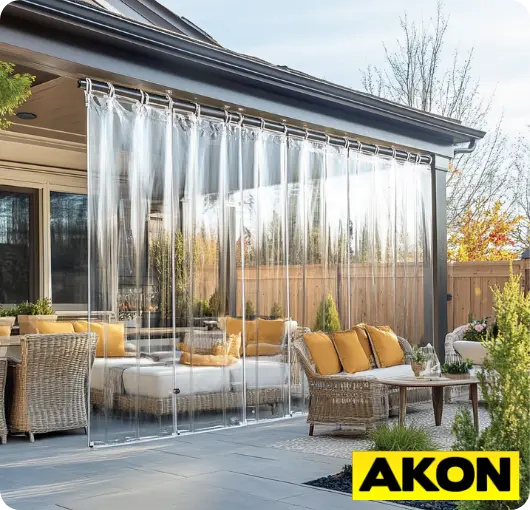
A flexible and reasonably priced way to create a windbreak on your patio are clear tarps. Made from robust, waterproof vinyl and reinforced with thick webbing along the edges for maximum strength and lifetime, these heavy-duty tarps This qualifies them for long-term use as well as in demanding weather.
Clear tarps, which are meant for a range of uses—residential, business, and industrial—can be used to cover patios, gazebos, decks, and other outside spaces. Being UV-rated to survive continuous sunshine, they provide defense from wind, rain, and even the sun.
These very flexible tarps have grommets, pockets, and even zipper splits for simple and secure installation. Their adaptability lets them fit different patio forms and sizes, which makes them a handy and personalized way to build a windbreak.
The Pros and Cons
Pros of Clear Tarps With Grommets:
- Affordability: Generally speaking, clear tarps are less expensive than more permanent windbreak projects like hedges or pergolas.
- Multipurpose: Appropriate for many uses, including patios, decks, and other outdoor spaces is versatility.
- Ease of Installation: Relatively simple to install and take down, providing adaptability in use.
- Highly Customizable: Customizable in several sizes to match varying patio width.
- Provides Shelter: Offers basic defense from light winds, rain, and some sunshine.
Cons of Clear Tarps With Grommets:
- Restricted Wind Protection: Might not work against very high winds.
- Aesthetics: Might not be the most beautiful choice available for every patio.
- Can Trap Heat: Especially on sunny days, can greatly raise the temperature within the enclosed area.
- Limited Durability: May need occasional repairs or replacements; may not be as sturdy as more permanent buildings.
- Can Limit Your View: Can limit perspectives of the surroundings' scenery.
Tarps With Clear Windows
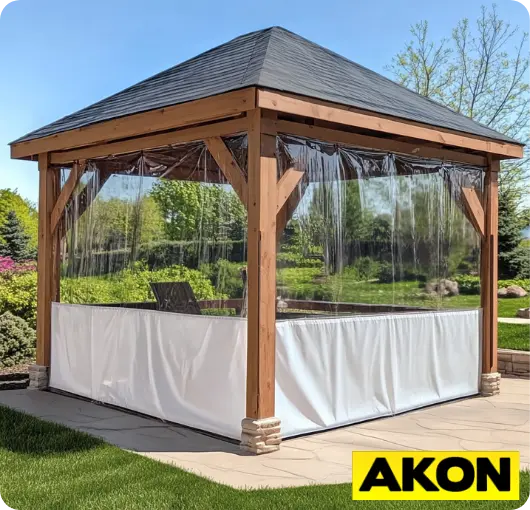
Tarps with Clear Windows present a flexible and useful way to create a protected outdoor area. Built with heavy-duty, UV-resistant vinyl to withstand several weather situations, these tarps are made with longevity in mind.
With their clear windows, these tarps protect from wind, rain, and other elements while nevertheless allowing natural light and view. Offering a selection of sizes and configurations to match various outdoor environments, they are tailored to meet your particular need.
Simple and safe installation is made possible by grommets, pockets, even zipper splits. These tarps offer a useful and flexible way to create a comfortable and fun outdoor living environment whether your outdoor space is a patio, gazebo, or deck.
The Pros and Cons
Pros of Tarps with Clear Windows:
- Weather Protection: Provides cover from wind, rain, and light snow thereby extending your outdoor enjoyment.
- Natural Light: Natural light lets in to make the space brighter and more welcoming.
- Versatility: Appropriate for many outside areas, including patios, decks, gazebos, and more is versatility.
- Cost-Effective: Usually more reasonably priced than permanent constructions like screened-in porches.
- Ease of Installation: Relatively simple installation and removal allow flexibility for seasonal use.
Cons of Tarps with Clear Windows:
- Restricted Wind Resistance: Might not provide sufficient defense against high winds.
- Aesthetics: Perhaps not the most visually appealing choice available for every patio.
- Can Trap Heat: On hot days, heat build-up can trap heat inside and make things uncomfortable.
- Potential for Condensation: Moisture may condense inside the tarp, therefore creating dampness.
- May Be Worn Out Over Time: May be prone to tears, punctures, and fading with time.
Outdoor Curtains - Custom Shape Tarps
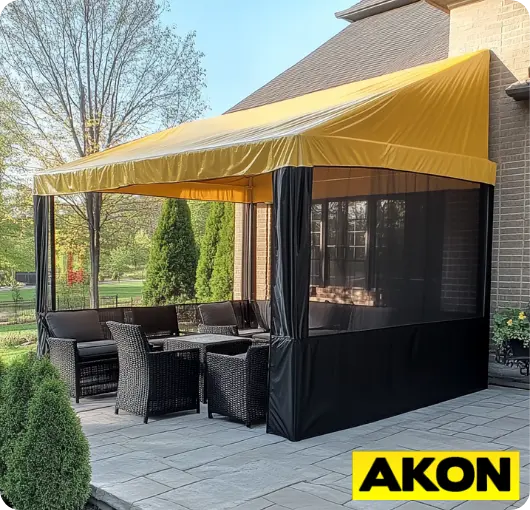
Use sturdy and personalized Custom Shape Tarps to enjoy your outdoor living area all year long. These adaptable panels are meant to efficiently block wind, therefore transforming your patio into a warm and comfortable space.
Resized to exactly suit any opening, these tarps offer optimal wind protection and effortlessly complement your current patio design. Built to last from heavy-duty industrial-strength vinyl, these tarps are reinforced with rust-proof grommets and edge webbing.
Appropriate for a broad spectrum of outdoor areas including patios, decks, gazebos, and more. Designed to fit your particular requirements, these tarps let you create a windbreak ideal for the design and scale of your patio.
The Pros and Cons
Pros of Custom Shape Tarps:
- Customization: The main advantage is their capacity to be custom-sized to fit almost any hole, thereby guaranteeing a tight and efficient windbreak.
- Durability: Made from heavy-duty vinyl with reinforced edges and rust-proof grommets, these tarps are meant to last years and resist severe weather.
- Versatility: Appropriate for a variety of outdoor locations including patios, decks, gazebos, loading docks, and more.
- Weather Resistant: Designed to ward against wind, rain, and even strong sunshine, weather resistance For prolonged sun exposure, UV-resistant choices abound.
- Budget-wise: Custom tarps provide a less expensive way for wind protection than more permanent constructions like glass enclosures.
Cons of Custom Shape Tarps:
- Aesthetics: Depending on the design of your patio, even if useful they might not be as aesthetically beautiful as some other windbreak choices.
- Maintenance: Maintenance calls for sporadic dust, filth, and trash removal from cleaning.
- Restricted Visibility: Based on the tarp's size and location, can block views.
- Potential Damage: Strong gusts or large items could also cause the tarp damage.
- Temporary Solution: Although strong, they are not as permanent as a built-in windbreak and could have to be taken down or kept under storage during very bad storms.
Landscaping
Windbreak Hedges

Rows of closely spaced shrubs or trees called windbreak hedges naturally block wind. For your patio's windbreak, they are a green and sustainable choice.
Commonly utilized shrubs for windbreak hedges are deciduous like boxwood and privet as well as evergreen shrubs like arborvitae, juniper, and yew. These year-round protective plants even help in the winter.
Highly sustainable are windbreak hedges. By consuming carbon dioxide and hence enhancing air quality, they help to create a better environment. They also give insects and birds among other species home.
Recommended for numerous purposes are windbreak hedges. They are a natural and aesthetically beautiful fix that can improve the appeal of your outside area. Once set, they demand little upkeep and can survive for several years.
The Pros and Cons
Pros of Windbreak Hedges:
- Natural Beauty: Your yard gains a little natural beauty with windbreak hedges. When compared to manmade constructions, they can produce a more aesthetically pleasing and welcoming outside environment.
- Eco-friendly in various respects, these hedges benefit the surroundings. Through their absorption of contaminants, they assist to clear the air. They also give other helpful insects, such butterflies and birds, homes.
- Low upkeep: Usually after the hedge is grown and established, little upkeep is needed. While watering and occasional pruning may be required, it is far less effort than always changing or replacing synthetic windbreaks.
- Last a Long Time: Windbreak hedges kept correctly can offer years of efficient wind protection. They are a long-term fix that will endure far beyond many synthetic choices.
- Improve curb appeal of your house by keeping a well-maintaining hedge. Should you ever choose to sell, this will raise its worth.
Cons of Windbreak Hedges
- Takes Time to Grow: A hedge takes several years to attain its peak height and offer best wind protection. You won't have instant cover from the breeze.
- Needs Initial Investment: Purchasing plants, soil supplements, and maybe expert installation might have a sizable initial outlay.
- Can Limit Sunlight: Depending on the height and density of the hedge, it could create shadows on your patio, thereby lowering the total sunshine intake.
- May Need Regular Trimming: Perhaps regular trimming is needed. Though less often than some other maintenance chores, you will have to occasionally cut the hedge to keep its form, size, and efficacy.
- Can Be Affected by Pests and Diseases: Pests and diseases can affect hedges just like they can any plant. To keep the hedge in good shape, you might have to deal with problems including fungal diseases or insect invasions.
Trellis with Climbing Vines

Putting growing plants on a trellis is a beautiful and natural way to keep the wind off of your patio. The trellis gives plants like clematis, honeysuckle, and jasmine a way to climb and grow. When the plants are fully grown, they make a thick screen that can block the wind well.
This method is great because it's good for the environment and makes your outdoor area look more beautiful. It's also a cheap choice, since you only have to pay for the trellis and plants the first time.
Different things, like wood, metal, or even bamboo, can be used to make trellises. There are a lot of different kinds of climbing vines, and each one grows, flowers, and is hardy in its own way.
This method works best in places where the growing plants can grow in the weather. It takes time for the vines to grow and form a thick enough screen to keep the wind out.
The Pros and Cons
Pros of Trellis with Climbing Vines:
- Natural Beauty: Vines add a lovely, natural touch to your porch, making it look better and feel more welcoming.
- Eco-Friendly: Protection from the wind with plants is a long-term and eco-friendly choice.\
- Low-Cost (Eventually): The major cost is the money you spend on the trellis and plants at the beginning.
- Shade: As the vines grow, they can block some of the sun's rays, making your patio more comfy on hot days.
- Brings in Wildlife: A lot of climbing plants bring good bugs like bees and butterflies, which can make your garden more diverse.
Cons of Trellis with Climbing Vines:
- Allows Time to Grow: The plants need time to grow tall enough to effectively block the wind. You won't have a place to stay right away.
- Needs Maintenance: Vine plants need to be watered and pruned regularly. They may also need fertilizer and pest control from time to time.
- Can Spread: Some climbing plants can grow very quickly and spread to other areas if they are not controlled properly.
- Might not be strong enough for very strong winds: The windbreak might not be strong enough to stand up to very strong winds, depending on the type of vine and how dense the leaves are.
- Could Block More Sunlight: As the vines get thicker, they could stop more sunlight from getting to your porch.
Trees

One amazing natural approach to build a windbreak is using trees. Along with shielding your outside area from the wind, they accentuate its beauty and charm.
Consider trees as a natural barrier, shielding your patio from the wind and so fostering a more serene and leisureful environment. They also benefit the environment. Trees give birds and other animals shelter and assist to clean the air we breathe.
Trees provide a long-term, sustainable solution even if it takes time for them to get large enough to be effective windbreaks. You can select deciduous trees like maple or oak, or evergreen trees like pine or fir that remain green all year long.
Naturally, the correct trees for your area and temperature are crucial. You also have to allow them sufficient space for expansion.
The Pros and Cons
Pros of Trees:
- Natural Beauty: Trees give your landscape character and charm, thereby transforming the more pleasant and peaceful outdoor environment.
- Long Term Protection: Once grown, trees offer efficient, long-term wind shelter.
- Eco Friendly: Natural and sustainable, trees help the environment by bettering air quality and provide habitat for wildlife.
- Provides Shade and Cooling: Many trees also offer shade, which during hot summer months could help to chill your patio.
- Increased Property Value: Mature trees may dramatically improve the curb appeal and value of your house.
Cons of Trees:
- Time Investment: Trees develop to a size that offers efficient wind protection over time, hence this requires time.
- Can Take Up Big Amount of Space: Trees need enough room to flourish and mature, hence not all patios would be fit for them.
- Potential Overgrowth: Some trees could need frequent pruning to keep their size and form and avoid causing interference with buildings or electricity lines.
- Root System: Tree roots sometimes cause damage to patio foundations or compromise of subterranean utilities.
- Seasonal Variation: Deciduous trees could shed their leaves in the fall, therefore less effective as windbreaks at some times of year.
Fencing
Bamboo Screens

Weaved bamboo poles form bamboo screens. They provide a tasteful and natural approach to shield wind from your patio, therefore enhancing the natural beauty of your outdoor area.
Bamboo is a fast renewable resource, hence bamboo screens are environmentally sustainable. By obscuring the view from neighbors or onlookers, they also offer some seclusion. Many bamboo screens call only little tools and effort to install.
One may make good use of bamboo screens all year round to block wind. In windy spring and fall, they really come in handy.
All things considered, bamboo screens provide a superb natural and fashionable windbreak for your patio. This aesthetically pleasing and environmentally friendly fix can improve your outdoor living.
The Pros and Cons
Pros of Bamboos:
- Rapid Growth: Bamboo matures fast and offers wind protection sooner than many trees.
- Dense Foliage's thick, leafy growth provides great wind blockage.
- Aesthetics: Your patio will have a distinctive, tropical vibe.
- Versatility: Provides customizing by means of several sizes and forms (clumping or running).
- Eco Friendly: Fast expanding renewable resource that can assist lower your carbon footprint is eco-friendly.
- Low Maintenance: Generally speaking, low maintenance calls for little pruning as compared to many trees.\
Cons of Bamboos:
- Invasive: Some bamboo species can be quite invasive, spreading aggressively under ground. Choosing clumping varieties carefully is absolutely vital.
- Potential Damage: Strong winds have occasionally caused bamboo damage that calls for replacement or repairs.
- Aesthetics: Depending on your preferred degree of shadow, the thick vegetation could obscure sunlight for some.
- Limited Hardiness: Certain bamboo types might not be fit for colder climes.
Vinyl Patio & Porch Enclosures
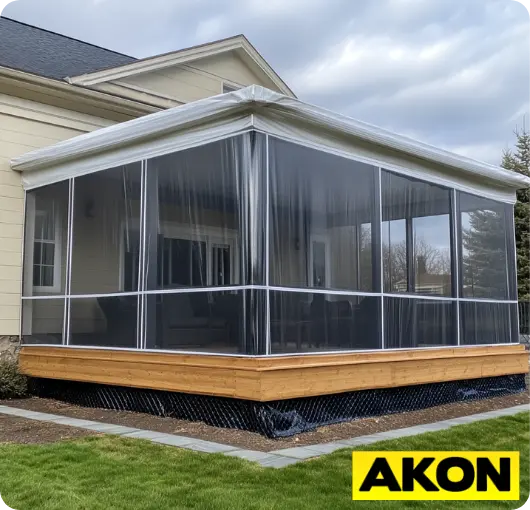
Vinyl patio and porch enclosures are clear vinyl curtains designed to extend the usability of your outdoor living spaces. These enclosures create a sheltered environment by blocking wind, rain, and cold air, allowing you to enjoy your patio or porch even during colder months.
Made from high-quality, double-polished PVC, these enclosures are durable and easy to maintain. They can be quickly installed and removed for seasonal use, making them convenient and flexible. Compared to rigid insulated panels, they are more affordable, easier to store, and quicker to install.
Vinyl enclosures offer several benefits, including improved energy efficiency by reducing heat loss and providing a warmer microclimate. They also help to keep out noise from neighbors or traffic, creating a more peaceful outdoor environment. Furthermore, they can enhance the versatility of your outdoor space, allowing you to use it for a wider range of activities throughout the year.
The Pros and Cons
Pros of Vinyl Patio & Porch Enclosures
- Extended Outdoor Living: Use your patio in every season! Rain, wind, snow; you can still unwind outside quite pleasantly.
- Protection from Insects: Keep those annoying mosquitoes and other bugs off to make your outside area more pleasant.
- Climate Protection: Weather Keep warm and dry under rain and in cold conditions.
- Extension: Feels as though you have added another room to your house, therefore increasing the living space available.
- Added Value: Can greatly raise the worth of your house, so attractive to possible purchasers.
Cons of Vinyl Patio & Porch Enclosures
- Claustrophobic: May cause your patio to seem less open and airy.
- Can Trap Heat: On sunny days, especially in cases with insufficient ventilation, heat trapping can cause quite heated interior conditions.
- May Limit Views: Could block your view of the surrounds.
- Can be costly: Installation and material costs can be somewhat high.
- May Need Permits: Before building an enclosure, your local government could require permits.
Wooden Panels

On your patio or in your yard, wooden panels will greatly cut wind. They function as a barrier, slowing down the breeze and so making the outside environment more pleasant.
These panels improve the natural beauty of your surrounds in addition to provide wind cover. Your outdoor space will look great with wood, and you may select from several varieties to complement your current design.
Choose responsibly produced wood for your panels to be sure they last. This guarantees that the wood originates from responsibly run-down woods, therefore reducing environmental effect.
Using wooden panels allows you to make a deliberate decision supporting sustainable forestry methods and enhance the outdoor experience.
The Pros and Cons
Pros of Wooden Panels:
- Wind-Reduction: Wooden panels are great at reducing wind, so producing a calmer and more pleasant outdoor environment.
- Natural Aesthetic: Wood easily fits most garden designs and gives any outdoor space natural charm and warmth.
- Versatility: From rustic to modern, wood allows you to personalize the appearance to fit your tastes by means of a great range of designs.
- Durability: Made from premium timbers like cedar or redwood, wooden panels can last many years with appropriate care.
- Eco-friendly choices include sustainably obtained wood, therefore supporting responsible forestry methods and reducing environmental effect.
Cons of Wooden Panels:
- Maintenance: To stop rot, insect damage, and fading, wooden panels could call for routine maintenance including cleaning, staining, or sealant application.
- Cost: Some other windbreak materials may be less costly than premium wood.
- Visual: Though aesthetically pleasing, some could find the look of wood overly "busy" or wish for a more understated approach.
- Fire Risk: Wood is combustible; hence one should keep appropriate distance from heat sources and take into account fire-resistant treatments.
- Potential for Warping and Cracking: Changes in temperature can cause wood to deform or crack; this is particularly true in cases of improper treatment or installation.
Freestanding
Freestanding Windbreak Panels

Like moveable barriers for your patio, freestanding windbreak panels are They are fantastic since you can simply move them around to block wind from wherever. Imagine yourself having a lovely dinner on your patio and the wind is blowing. You can just slide a freestanding screen to the side where the wind is stronger and enjoy your dinner in peace.
These panels are available in many different designs; some are composed of metal, some of wood, and some of unique materials designed to resist all kinds of weather. There are shorter ones that merely offer some cover and tall ones that block a lot of wind.
They are really handy since they are easy to relocate. They can be placed in several areas on your patio or even kept stashed when not in use.
Usually needing no installation or setup, freestanding panels are easy to install. Their range of materials and designs lets you select choices that fit your own tastes and current patio décor.
The Pros and Cons
Pros of Freestanding Windbreak Panels:
- Easy to Move: Moving them around your patio will help you to block wind from many directions. This is fantastic in cases of regular direction change in the wind.
- Portable and Storable: When not in use, they are simple to move and store. When the weather is quiet or you wish to enjoy the full sun, you can simply stow them.
- Easy to Install: Most freestanding panels may be set up fast and call for little installation.
- Good for Renters: For tenants who cannot permanently alter their outdoor area, they are an ideal solution.
- Versatile: Versatile: They fit your needs and the appearance of your patio by means of their several designs and sizes.
Cons of Freestanding Windbreak Panels:
- May Not Be Strong Enough: Especially in windy conditions, they might not be sufficient to stop very strong gusts.
- Can Look Temporary: Some people may find them to seem a little transient or less aesthetically appealing than more permanent fixes.
- May Tip Over: In really severe winds, they might flip over or become unstable.
- Might Not Provide Complete Protection: Might Not Offer Complete Protection: Given gaps between the panels, they might not totally block the wind.
- May Limit Views: Depending on their size and location, they can obscure some of your patio view.
Outdoor Umbrellas

Although their main purpose is to give shade, outdoor umbrellas also somewhat shield against light breezes. Although they are not as efficient as committed windbreak solutions, in some cases they can be a good choice.
Underlying umbrellas creates a somewhat more sheltered space that provides brief respite from mild gusts. Easily moved about to offer shade and some wind protection in various parts of your patio, they are readily accessible.
Umbrellas are most suitable for low winds, hence keep this in mind. An umbrella can be readily overturned by strong gusts, therefore damaging the umbrella itself or nearby objects.
All things considered, outdoor umbrellas can provide some limited protection from light winds even if their main purpose is not one. They are a quickly accessible solution that can offer some brief respite from gusty circumstances. Still, dedicated windbreak technologies are usually more reliable and efficient for major wind protection.
The Pros and Cons
Pros of Outdoor Umbrellas:
- Readily Available: Many stores have umbrellas easily found and bought.
- Multi-Purpose: Mostly serving as shade, they also somewhat shield from light winds.
- Portable: You can quickly relocate them about your patio to offer different sections shade and wind protection.
- Affordable: Umbrellas differ widely in cost to suit most budgets.
- Stylish: Umbrellas can provide your patio's décor a fashionable accent.
Cons of Outdoor Umbrellas:
- Limited Wind Protection: Umbrellas only work against light breezes, thereby providing limited protection. Strong winds will readily turn them over.
- Restricted Coverage: An umbrella offers rather little area of protection.
- Not Durable in Strong gusts: Strong gusts may bend the pole or rip the canopy, therefore compromising the umbrella.
- May Not Be Stable: Strong gusts allow umbrellas to be readily blown over, maybe damaging the umbrella or nearby things.
- Mostly for Shade: Umbrellas have little wind protection capacity and are made especially for shade.
Privacy Screens

One flexible way to build a windbreak on your patio is with privacy screens. Their range of materials provides both aesthetic appeal and utility.
Privacy screens are commonly made of wood, bamboo, metal, and even synthetic materials woven in some fashion. Various kinds of wood, such cedar or redwood, which are prized for their resilience to the elements and longevity, can be used to create wood screens. While metal screens, such those composed of aluminum or steel, give a modern and sleek aspect, bamboo screens offer a natural and charming appearance. Often more reasonably priced and low-maintenance are synthetic materials such as woven vinyl or PVC.
Privacy screens can be used all year long. They offer a barrier against powerful gusts during windy seasons, therefore improving the outdoor living environment. In warmer months, they might provide some sun protection and shade.
Using privacy screens as your patio windbreak call very little tools and knowledge; hence they are rather easy to install. Their many designs and sizes let you choose the ideal match for your patio and tastes. Moreover, they can improve the privacy of your outside area, so fostering a more seclusion and tranquilly.
The Pros and Cons
Pros of Privacy Screens:
- Easy to Install: Many privacy screens are meant for simple installation. You might only have to fasten them to your fence or ground anchor them.
- Lots of Choices for Materials: There are privacy screens composed of wood, bamboo, metal, or even woven fabrics. This provides you with many choices from which to select one that fits your budget and style.
- Good for Privacy: As their name implies, they contribute to maintain the privacy of your patio. Neighbors or onlookers peering in won't cause you concern.
- Stylish: Actually, a nicely selected privacy screen can improve the appearance of your patio. With bamboo or a contemporary style using metal, they can accentuate natural beauty.
- Easy to Maintain: Most privacy screens demand little maintenance. You might only need to give them sporadic cleaning off-peak.
Cons of Privacy Screens:
- Might Not Stop Strong Winds: Though they can block some wind, in really windy conditions they might not be robust enough.
- Can block sunlight: Privacy screens will stop some of the sunshine from getting to your patio depending on their type and placement.
- Might Not Look Great Everywhere: Not every kind of privacy screen will look fine with every kind of home style.
- Possibly Not As Effective As Other Choices: A privacy screen might not be as good in totally blocking severe winds than something like a retractable awning.
- Might Not Be Perfect for All Climates: A privacy screen might not be the ideal option if you reside in a location with really strong winds.
Other Patio Windbreak Options
Retractable Awnings

A retractable awning is essentially what that is! Attaching to your house, they can be stretched to cover your patio. This shields the wind, offers cover from unexpected rain showers, and shadows from the blazing sun.
Strong textiles like acrylic or polyester are used to make them, and often lightweight and robust metal forms the frame. They are especially useful in the spring and summer when the sun is bright; nevertheless, on cool days they can also be useful in blocking the wind.
Retractable awnings are fantastic since they enable you to more often appreciate your patio. On hot days, they help you stay cool so you less need to depend on air conditioning. Given that it saves energy, this is beneficial for the surroundings. They also enhance the whole appearance of your house and help your patio to look better.
The Pros and Cons
Pros of Wooden Panels:
- All-in-one solution: They shield from rain and offer sun shade in addition to blocking the wind.
- Simple to use: You just roll them out as needed and retract them to enjoy the sun.
- Look great: They can provide your patio more polished and fashionable finish.
- Block the sun to help keep your patio cool, so you won't have to depend so much on air conditioning.
- Strong winds, rain, and sun damage can all be avoided from your outdoor furniture by using them.
Cons of Wooden Panels:
- Can be costly: Given some alternative windbreak choices, their investment can be somewhat large.
- Certain models may be difficult to install and could call for a specialist.
- Might not be sufficient for really high winds: Although they provide decent wind protection, they could not be able to resist very severe gusts.
- Can limit sunlight: You'll have to fully retract your awning to enjoy sunlight.
- May need some upkeep; you could have to periodically wash them and look for any damage.
Pergolas with Curtains
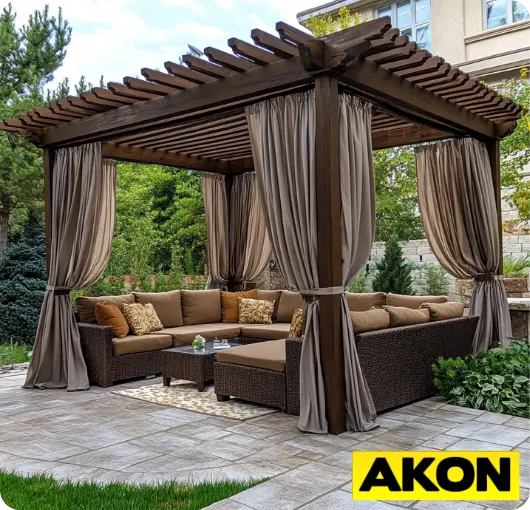
A pergola with curtains could be used all year long. The curtains can block the wind and cover you from the sweltering sun in summer. They can assist to keep the wind out and warm your patio in the colder months.
Better for the environment is to use natural materials for the pergola—wood—and the curtains—canvas. Pergolas are also beneficial since they allow some air and sunlight through, so avoiding overly stifling conditions.
Curtain-equipped pergolas look rather great and enhance the uniqueness of your patio. The curtains can be opened and closed with simple effort based on the weather. Moreover, you might also cultivate plants on the pergola to provide some vegetation and extra shadow.
All things considered, pergolas with curtains are a fantastic approach to make your patio a pleasant and fun location to be, independent of the temperature.
The Pros and Cons
Pros of Wooden Panels:
- Stylish: Your patio can seem quite elegant with curtains on a pergolas.
- Cozy: They design a welcoming outdoor living area.
- Versatile: You could wear them during all seasons. Summertime they offer shade and wind protection. They assist to block cold winds in winter.
- Customizing: You can select several kinds of curtains to fit your needs and aesthetic taste.
- Growing plants on the pergola will naturally enhance the surroundings and provide more shade.
Cons of Wooden Panels:
- Maybe costly: Constructing a pergola and purchasing drapes might be expensive.
- Might not be sufficient for really high winds: Their degree of protection in really strong winds will depend on the materials and construction.
- Can limit sunlight: You will have to totally open the curtains if you wish to enjoy full sun.
- Needs some upkeep. You could have to routinely clean the drapes and pergola.
- Possibly inappropriate for all climates: They might not be the most sensible choice in places with really strong winds or plenty of rain.
Mosquito Curtains | Mesh
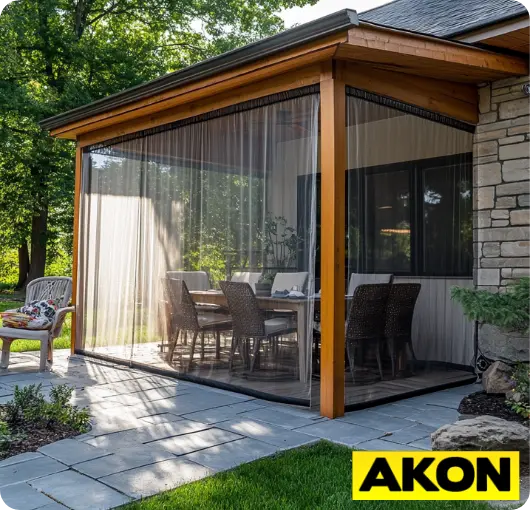
A sensible and reasonably priced way to make a more pleasant outdoor living area is with mosquito netting. These custom-fitted curtains let you to rest free from the continual nuisance of bug bites by efficiently discouraging mosquitoes and other insects.
Beyond only controlling insects, mosquito netting somewhat blocks mild breezes, thereby improving your outdoor comfort. These curtains need just minimal DIY knowledge since they are meant for simple installation. Retractable tracks also provide flexibility and let you quickly open and close the netting as needed.
Mosquito netting makes the outside environment more pleasant whether your summer BBQ is being watched, a game is being watched, or just you unwinding on your patio.
The Pros and Cons
Pros of Mosquito Curtain Enclosure:
- Dual Protection: offers some light wind protection as well as insect control.
- Relatively cheap when compared to other windbreak solutions.
- Usually requiring little hardware: Most homeowners can install this easy-to-learn project.
- Good airflow made possible by airy and open design helps to avoid a stuffy patio.
- Versatility: Applied on a variety of outdoor constructions like patios, porches, and gazebos is
Cons Mosquito Curtain Enclosure:
- Restricted Wind Protection: Only good against light breezes; powerful gusts will go right through.
- May not be the most visually appealing choice for every patio.
- Can Sag or Tear: Because of wear and tear or weather, may need for sporadic repairs and modifications.
- May not totally enclose the area, allowing openings where wind may pass.
- May not be as lasting as more substantial panels or hedges, two more strong windbreak choices.
Choosing the Right Windbreak for Your Patio
Understand Your Needs
First of all, you should know your particular needs before choosing a windbreak for your patio. You really need how much wind protection? Are you trying to defend yourself from severe gusts or decrease soft breezes? Another key factor is privacy. Do you want a more remote outside location? Another consideration is the desired degree of shadow. Does the windbreak need to offer sun-shade? At last pay attention to your own style. Would you want a more conventional approach, a modern look, or a naturalistic one?
Consider Your Location & Climate
The most appropriate windbreak is largely influenced by your location and climate. Evaluate your local area's windiness. You will want a substantial and solid windbreak if you often face heavy gusts. Analyze the local temperature trends. Do you run into strong winds, snowfall, or severe rain? Choose materials resistant to these factors. Think about the sun your terrace gets. If you spend much time in the sun, pick a windbreak with shadow.
Explore Your Options
Discover the several choices for windbreaks at hand. Beautiful and natural solutions abound from natural windbreaks including trees and bushes. They do, however, take time to flourish and can call for continuous care. Constructed windbreaks with varied degrees of seclusion and wind protection include screens made of wood, metal, or fabric.
They can be built to retract as needed or secured in place. For wind and shade protection, fabric curtains present a fashionable and reasonably simple-to-install choice. Though they can be more costly, retractable awnings give some wind protection as well as shade. Though they might be expensive and may call for permits, solid walls provide best wind protection.
Think About Practicalities
Selecting a windbreak requires careful thought from practical standpoint. Analyze the simplicity of installation. Installation of the selected windbreak will be how difficult? Will you need certain tools or knowledge? Evaluate the continuous maintenance needs. Does the windbreak call for frequent repairs or cleaning?
If you choose a retractable solution, think about how you might keep it somewhere else than in use. Give safety top priority by making sure the windbreak is firmly fixed to stop it from being blown across in heavy gusts.
Get Quotes and Compare
Get quotes for several choices from nearby vendors and installers. Examine costs for supplies, warranties, pricing, and installation. Review comments from other consumers to learn about the longevity and quality of several choices.
Make the Best Choice
In the end, choose the windbreak that most fits your particular needs, financial situation, and taste in style. Ask queries of local landscaping or home improvement experts without delay for direction.
Summary
Your budget, the general state of the weather, and your desired degree of protection and aesthetics all influence the appropriate patio windbreak you choose.
While mid-range solutions like outdoor curtains and roll-up curtains strike a mix of design and utility, budget-conscious choices like clear tarps and mosquito netting give basic protection. Vinyl or insulated patio enclosures are great for year-round use and ultimate protection.
As you decide, give sustainability, simplicity of installation, and durability top priority. Choose environmentally responsible solutions whenever you can or use repurposed fabrics.
Carefully balancing these elements will help you choose the best windbreak to improve the enjoyment of your patio and provide a pleasant outdoor haven.
